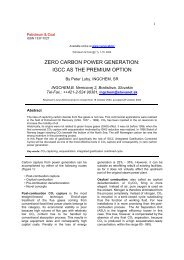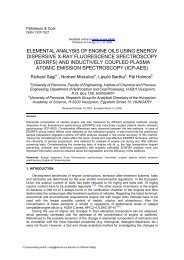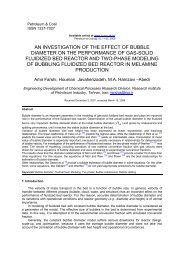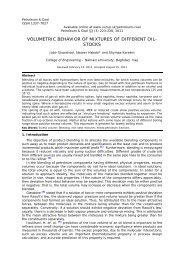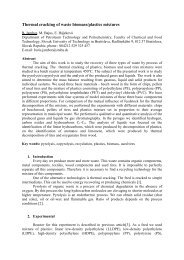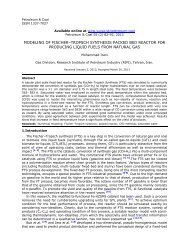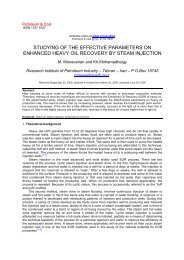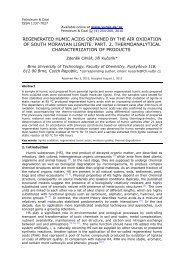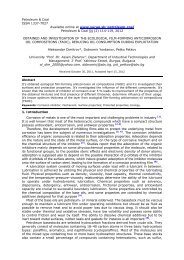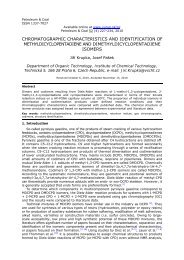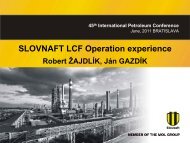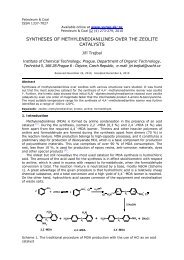regenerated humic acids obtained by the air oxidation of south ...
regenerated humic acids obtained by the air oxidation of south ...
regenerated humic acids obtained by the air oxidation of south ...
You also want an ePaper? Increase the reach of your titles
YUMPU automatically turns print PDFs into web optimized ePapers that Google loves.
Jiří Kučerík et al./Petroleum & Coal 50(3) 48-54 (2008) 51constant ei<strong>the</strong>r at 25°C or 50°C. The second way <strong>of</strong> <strong>oxidation</strong> was carried out in <strong>the</strong> oven in which <strong>the</strong>lignite sample was let to be oxidized put on <strong>the</strong> floor at 85°C for <strong>the</strong> chosen time period.Humic substances were extracted from pretreated and parental lignite according to <strong>the</strong> proceduredescribed earlier [13] . Briefly, a lignite fraction was mixed with <strong>the</strong> aqueous 0.5 M NaOH and 0.1MNa 4 P 2 O 7 solution (1:10) and stirred for 3 hours. After centrifugation, <strong>the</strong> supernatant was treated with<strong>the</strong> concentrated HCl until pH was about 1 in order to precipitate <strong>the</strong> <strong>humic</strong> <strong>acids</strong> (fraction HA). HAwere <strong>the</strong>n treated with 0.5% (v/v) HCl-HF solution overnight to remove residual ashes, dialyzed(Spectra/Por® dialysis tubes, 1000 Mw cut-<strong>of</strong>f) against distilled water until chloride-free. Obtainedproducts were dried in <strong>the</strong> oven to constant weight.All <strong>humic</strong> samples (50 mg) were suspended in CO 2 free distilled water (60 ml) and titrated to pH 7with 0.1M NaOH solution employing an automatic titrator as described earlier [14] . The resulting sodiumhumates were freeze-dried and homogenized in an agate mortar for fur<strong>the</strong>r HPSEC analyses.High performance size exclusion chromatography (HPSEC)The HPSEC system Agilent consisted <strong>of</strong> a pump equipped with two detectors in series: a UV/VISdetector set to 280 nm for <strong>humic</strong> analyses, and a refractive index detector (RI). An automatic injector,with a 100 μl sample loop, was used to load HPSEC solutions and a Phenomenex Biosep S2000 (600× 7.5 mm) column was used for size exclusion separations. The column was preceded <strong>by</strong> a BiosepGuard column and a 0.2 μm stainless-steel inlet filter. Flow rate was set to 0.6 ml min -1 while <strong>the</strong>HPSEC eluent was a 50 mM NaH 2 PO 4 .H 2 O solution adjusted to pH 7 with 1M NaOH. The bufferconcentration was chosen to have a constant ionic strength <strong>of</strong> 50 mM in order to minimize ionicexclusion or hydrophobic interactions with <strong>the</strong> column.All solutions were filtered through quartz filters (Glass Micr<strong>of</strong>ibre Filter Whatman International,LTD) before injection. The HPSEC analyses were conducted in duplicate and no significantdifferences were observed between measurements. For <strong>the</strong> calculation <strong>of</strong> weight average molecularweight (Mw) following equation was used:MW=N∑i = 1N(h M )∑i = 1ihiiwhere M i and h i are <strong>the</strong> molecular weight and <strong>the</strong> height <strong>of</strong> each i-th fraction in <strong>the</strong> chromatogram, respectively.Standards <strong>of</strong> known Mw such as polysaccharides (PS) <strong>of</strong> 186, 100, 23.7 and 12.2 kD, (PolymerSciences Laboratories, UK) and sodium polystyrenesulphonates (PSS) <strong>of</strong> 169, 123, 30.9 and 6.78 kD(Polymer Standard Service, Germany) were used for column calibration. Calibration curves weresemi-log linear over <strong>the</strong> range defined <strong>by</strong> standards and were used to obtain <strong>the</strong> molecular weights <strong>of</strong><strong>humic</strong> samples.FTIR spectroscopyConventional KBr pellet technique was used. Humic samples previously dried at 105°C for 2hours and cooled and stored in desiccator were mixed in agate mortar with KBr (1:200 w/w). For thispurpose Nicolet Impact 400 was employed.3. Results and discussionProduction <strong>of</strong> RHA extracted from South Moravian lignite has been already published [12] . It hasbeen demonstrated that <strong>the</strong> content <strong>of</strong> RHA can be increased from 20% to 60% using nitric acid or45% using hydrogen peroxide. Never<strong>the</strong>less, such approach was associated with a loss <strong>of</strong> a hugeamount <strong>of</strong> carbon due to <strong>the</strong> intensive <strong>oxidation</strong> attack.3.1 Influence <strong>of</strong> particle size on <strong>the</strong> yield <strong>of</strong> <strong>humic</strong> <strong>acids</strong>In <strong>the</strong> first step, <strong>the</strong> attempt was to evaluate <strong>the</strong> influence <strong>of</strong> particle size on <strong>the</strong> yield <strong>of</strong> extraction<strong>of</strong> <strong>humic</strong> <strong>acids</strong> from lignite. For this purpose 3 particle size fractions mentioned in Experimental wereused. Table 1 reports <strong>the</strong> results <strong>of</strong> <strong>the</strong> experiment.Table 1 Yield <strong>of</strong> extraction <strong>of</strong> <strong>humic</strong> <strong>acids</strong> from lignite <strong>of</strong> various particle sizesFraction (mm) 1-0.5 0.5-0.125 0.125>Yield (%) 12.0 23.0 22.0
Jiří Kučerík et al./Petroleum & Coal 50(3) 48-54 (2008) 52One can see that <strong>the</strong> particle size is an important parameter for <strong>the</strong> production <strong>of</strong> <strong>humic</strong> <strong>acids</strong>.While large particle diameter provided a relatively low yield, particles smaller than 0.5 mm gave yieldabove 20%. It is logical since lower particle size is connected with larger area and it seems that <strong>the</strong>extraction agent could not reach to <strong>the</strong> particles interior and extracted solely <strong>the</strong> <strong>humic</strong> material from<strong>the</strong> particle surface. Additional conclusion can be made considering that <strong>humic</strong> <strong>acids</strong> are moreabundant in particles with lower diameter. This assumption can be justified <strong>by</strong> <strong>the</strong> fact that in <strong>the</strong>structure <strong>of</strong> lignite, <strong>the</strong>re can be identified parts <strong>of</strong> different degree <strong>of</strong> coalification as well as nondecomposedmoieties <strong>of</strong> parental phytomass having different mechanical properties.Therefore, in <strong>the</strong> next experiments, different fractions were used to test <strong>the</strong> efficiency <strong>of</strong>suggested <strong>oxidation</strong> methods.3. 2 Oxidation in a fluid reactorThis part <strong>of</strong> <strong>the</strong> work has been devoted to <strong>the</strong> evaluation <strong>of</strong> influence <strong>of</strong> <strong>air</strong> <strong>oxidation</strong> on <strong>the</strong> yield<strong>of</strong> RHA extracted from oxidized lignite. For this purpose <strong>the</strong> fraction 1-0.5 mm was chosen. The<strong>obtained</strong> data are summarized in Table 2.Table 2 Oxidation <strong>of</strong> fraction 0.5-1 mm in <strong>the</strong> fluid reactorOxidation parameters24 hours at25°C72 hours at25°C120 hours at25°C72 hours at50°CYield* (%) -15.63 -7.97 75.42 5.46*Increase (+) or decrease (-) with respect to <strong>the</strong> value given in Table 1As can be seen in Table 2, <strong>the</strong> <strong>oxidation</strong> in fluid reactor did not give rise to <strong>the</strong> yield increase in allcases. We assume that it is caused <strong>by</strong> <strong>the</strong> composition <strong>of</strong> <strong>the</strong> particles having diameter 0.5-1 mm. Influid state particles are supposed to be under <strong>the</strong> mechanical stress (milling) and thus <strong>the</strong> particle sizeis decreasing (verified <strong>by</strong> a parallel experiment). Such processes should lead to <strong>the</strong> increase in <strong>the</strong>yield <strong>of</strong> <strong>humic</strong> <strong>acids</strong>. However, it seems that such way <strong>of</strong> <strong>oxidation</strong> preferably supports <strong>the</strong> <strong>oxidation</strong> <strong>of</strong>COOH groups <strong>of</strong> <strong>humic</strong> <strong>acids</strong> responsible for <strong>the</strong>ir solubility. Kinetics <strong>of</strong> <strong>oxidation</strong> <strong>of</strong> o<strong>the</strong>r structures,resulting in formation <strong>of</strong> o<strong>the</strong>r carboxylic groups is evidently slower which is indicated <strong>by</strong> <strong>the</strong> yield after72 hours at 25 and 50 °C and after 120 hours.3.3 Oxidation in stationary phaseIn this part <strong>of</strong> <strong>the</strong> work we have tested <strong>the</strong> influence <strong>of</strong> <strong>air</strong> <strong>oxidation</strong> on <strong>the</strong> yield <strong>of</strong> <strong>humic</strong> <strong>acids</strong>.Since <strong>oxidation</strong> in fluid reactor was not too sufficient for fraction 0.5-1 mm, we used <strong>the</strong> fraction 0.5-0.125 to see whe<strong>the</strong>r in this case <strong>the</strong> yield increase will be more intensive. Temperature 85°C waschosen with respect to <strong>the</strong> results reported recently, which indicated that at temperature above 80°Clipid fraction present in humified matter forming a specific domain is melted [15] and, thus, some parts <strong>of</strong>lignite are better accessible for oxygen diffusion. Again, similar trend as in case <strong>of</strong> fluid reactor hasbeen observed (Table 3). Oxidation <strong>of</strong> lignite brought about a decrease in <strong>the</strong> yield <strong>of</strong> RHA with <strong>the</strong>minimum after 120 hours <strong>of</strong> <strong>oxidation</strong>. Fur<strong>the</strong>r, an increase was observed which resulted in 18%abundance after 456 hours. It seems that lignite is relatively resistant to <strong>the</strong> <strong>oxidation</strong> attack under<strong>the</strong>se conditions and <strong>the</strong> kinetics <strong>of</strong> <strong>oxidation</strong> <strong>of</strong> carbon skeleton is relatively slow. Although <strong>the</strong>increase <strong>of</strong> HA content using such simple and chemically mild methodology is low, <strong>the</strong> next part isdevoted to <strong>the</strong> characterization <strong>of</strong> selected <strong>humic</strong> <strong>acids</strong> <strong>obtained</strong> during above-mentioned procedures.Table 3 Oxidation <strong>of</strong> fraction 0.5-0.125 mm in <strong>the</strong> static reactorOxidation period (hours) 72 120 240 456Yield* (%) -22.94 -43.65 -5.51 17.98*Increase (+) or decrease (-) with respect to <strong>the</strong> value given in Table 13.4 Characterization <strong>of</strong> HA and RHASelected samples were characterized for <strong>the</strong>ir elemental and ash content. Obtained values arereported in Table 4. Values are given in weight %. Chemical properties <strong>of</strong> <strong>humic</strong> <strong>acids</strong> extracted fromfraction 1.0-0.5mm did not practically differ from RHA prepared for 24 hours at 25°C, i.e. RHA1, so <strong>the</strong>latter is used as a reference. Samples produced in fluid reactor were denoted as follows: RHA2 andRHA3 are <strong>regenerated</strong> <strong>humic</strong> <strong>acids</strong> produced for 72 and 120 hours, respectively, and RHA4 stands for<strong>regenerated</strong> <strong>humic</strong> <strong>acids</strong> produced 72 hours at 50°C. Samples RHA5, RHA6, RHA7 and RHA8 wereprepared at 85°C in <strong>the</strong> static reactor for 72, 120, 240, 456 hours, respectively. Sample HA9represents <strong>humic</strong> acid extracted from parental lignite.
Jiří Kučerík et al./Petroleum & Coal 50(3) 48-54 (2008) 53Table 4 Elemental composition, ash and moisture content <strong>of</strong> parental and <strong>regenerated</strong> <strong>humic</strong> <strong>acids</strong>,ash content in all samples up to 2.2%, traces <strong>of</strong> sulphur are included in O content.C (%) H (%) N (%) O*(%) C/H C/O MoistureRHA1 56.07 4.82 1.28 37.22 11.75 1.52 8.34RHA2 57.37 4.80 1.36 36.47 11.95 1.57 7.63RHA3 56.62 4.89 1.34 37.15 11.58 1.52 7.85RHA4 56.81 4.45 1.29 37.45 12.76 1.52 8.16RHA5 56.91 4.66 1.37 37.06 12.21 1.54 7.61RHA6 57.21 4.97 1.29 36.53 11.51 1.57 7.98RHA7 57.72 4.72 1.26 36.30 12.22 1.59 7.03RHA8 57.42 4.84 1.29 36.45 11.86 1.58 7.48HA9 57.21 4.62 1.05 37.22 12.38 1.53 n.d.*calculated <strong>by</strong> differenceDecreasing C/H ratio appeared to be related to decreasing aromaticity or degree <strong>of</strong> unsaturation [13] .Basically, <strong>the</strong> higher C/H value <strong>the</strong> higher is <strong>the</strong> content <strong>of</strong> aromatic structures in <strong>humic</strong> material. RatioC/O indicates <strong>the</strong> proportion between oxygenated carbons and indirectly also <strong>the</strong> content <strong>of</strong> COOHgroups.In fact, <strong>the</strong> elemental content and its ratios did not show any remarkable changes in composition<strong>of</strong> RHAs. As mentioned previously, <strong>the</strong> reason can be seen in <strong>the</strong> kinetics <strong>of</strong> <strong>oxidation</strong> processes aswell as in <strong>the</strong> strength <strong>of</strong> <strong>oxidation</strong> agent.Fig. 2 shows a representative HPSEC <strong>of</strong> <strong>humic</strong> acid extracted from parental lignite detected <strong>by</strong> RIdetector, Table 5 reports <strong>the</strong> respective Mw <strong>of</strong> all HA and RHAs based on sodium salt polystyrenesulfonates (PSS) and polysaccharides (PS) calibration. Although <strong>the</strong> comparison <strong>of</strong> Mw among eacho<strong>the</strong>r has an importance, <strong>the</strong> values should be taken as apparental since <strong>the</strong>re is no <strong>humic</strong> materialwhich can be used for <strong>the</strong> molecular weight calibration [16] . Fur<strong>the</strong>r, as mentioned before, <strong>humic</strong> <strong>acids</strong>should be considered as a mixture <strong>of</strong> relatively small molecules and <strong>the</strong> data reflect more <strong>the</strong>aggregation properties <strong>of</strong> <strong>humic</strong> <strong>acids</strong>. Aggregates are stabilized <strong>by</strong> weak interactions (π-π, CH-π andvan der Waals and <strong>by</strong> H-bonds) which depends predominantly on <strong>the</strong> pH value and ionic strength [17] .In our case, analysis resulted in two distinctive peaks. As demonstrated recently, largest molecularsize fractions excluded from column first contain aromatic, alkyl and potentially carbohydrate-likecontent. The carbohydrate-like and <strong>the</strong> alkyl chain length seem to decrease with decreasing molecularsize. Progressive reduction <strong>of</strong> aromatic carbon atoms was also observed with decreasing molecularsize <strong>of</strong> <strong>the</strong> separated fractions. Fur<strong>the</strong>r, <strong>the</strong> abundance <strong>of</strong> hydrophilic molecules have been reported inlow molecular fraction [16,18] .Table 5. HPSEC based molecular weight calculated from UV and RI recordsPSS calibration (UV) PS calibration (RI)RHA1 9232 9444RHA2 12646 10760RHA3 13404 13710RHA4 7279 8442RHA5 15213 15030RHA6 10323 10840RHA7 12881 13540RHA8 17460 16940HA9 9961 ndIn contrast to <strong>the</strong> elemental analysis <strong>the</strong> HPSEC analysis revealed better <strong>the</strong> differences among<strong>humic</strong> sample (Table 5). Although <strong>the</strong>re is a shift between RI and UV calibrations, <strong>the</strong> mutualcomparison within HA and RHA is <strong>the</strong> same. Comparison <strong>of</strong> samples in <strong>the</strong> first set prepared in <strong>the</strong>fluid reactor shows <strong>the</strong> increase in Mw with increasing time <strong>of</strong> <strong>oxidation</strong>. On <strong>the</strong> o<strong>the</strong>r hand, elevatedtemperate <strong>of</strong> <strong>oxidation</strong> (50°C) brought a significant decrease in Mw. It means that <strong>the</strong> <strong>oxidation</strong> <strong>of</strong>lignite progressively liberates <strong>the</strong> soluble fractions with larger dimensions while temperature can cause<strong>the</strong>ir size reduction.The <strong>oxidation</strong> in stationary phase at 85°C showed also increasing tendency. The exception isRHA6 which gave a lower value <strong>of</strong> Mw than RHA5, although such value is still higher than that <strong>of</strong> HAextracted from non-treated lignite. It is noteworthy, that Mw <strong>of</strong> sample RHA8 is almost two-fold largerthan <strong>the</strong> original HA9.
Jiří Kučerík et al./Petroleum & Coal 50(3) 48-54 (2008) 54Fig. 3. Comparison <strong>of</strong> FTIR spectra <strong>humic</strong> acid extracted from parental lignite (HA) and<strong>regenerated</strong> <strong>humic</strong> acid (RHA8)FTIR spectroscopy measurement <strong>of</strong> <strong>humic</strong> <strong>acids</strong> and RHA showed typical spectra published anddescribed <strong>by</strong> many authors [3,12] . In this work only <strong>the</strong> FTIR spectra <strong>of</strong> HA and RHA8 are reported (Fig. 3).First, some notes to <strong>the</strong> attribution <strong>of</strong> peak wave numbers to chemical bonds vibrations. Fig 3 showsan intensive peak within <strong>the</strong> range 3400–3420 cm -1 which can be attributed mainly to <strong>the</strong> hydrogenbonded –OH; weak peaks in <strong>the</strong> region 2850–2960 cm -1 (aliphatic C–H stretching), strong sharp peaksaround 1710 cm -1 (C=O <strong>of</strong> COOH) and 1620 cm -1 (C=C stretching, C=O stretching <strong>of</strong> COO – , ketonicC=O and aromatic C=C conjugated with COO – ), a peak around 1510 cm -1 (N-H deformation, C-Nstretching vibration, C=C aromatic bounds) 1450–1400 cm -1 (aliphatic C–H bending, and COO –asymmetric stretching, and possibly C=C and C=N plane vibrations <strong>of</strong> heterocycles), peaks around1250 cm -1 (aromatic C, C-O stretch), a weak peak around 1050 cm -1 (C-O <strong>of</strong> polysaccharides and Si-O) were observed. The comparison <strong>of</strong> relative intensities <strong>of</strong> aliphaic and aromatic bands gave similarresults as those reported for elemental analysis. Fur<strong>the</strong>r, deeper analysis and comparison <strong>of</strong> peaks in<strong>the</strong> area 1710 cm -1 revealed <strong>the</strong> slight increase in abundance <strong>of</strong> esters in samples with highermolecular weight. Therefore, it can be assumed that <strong>oxidation</strong> <strong>of</strong> parental lignite led to oxidativedisruption <strong>of</strong> weak points in lignite resulting in progressive increase in yield <strong>of</strong> extractable <strong>humic</strong>material. It is likely that higher temperature toge<strong>the</strong>r with <strong>air</strong> atmosphere support <strong>the</strong> reactionsbetween COOH and OH- alcohol groups, i.e. esterification. The increase in molecular weight, i.e.increase in number <strong>of</strong> ester is significant especially for samples developed at temperatures above80°C when lipidic fraction is melted and recombination reactions can occur. Such conclusion is inagreement with <strong>the</strong> ability <strong>of</strong> <strong>regenerated</strong> <strong>humic</strong> <strong>acids</strong> to form gels having high water holding capacity [9] .However, in this work, gel formation was attributed to <strong>the</strong> higher ability <strong>of</strong> <strong>regenerated</strong> <strong>humic</strong> <strong>acids</strong> t<strong>of</strong>orm H-bridges due to <strong>the</strong> increase in content <strong>of</strong> COOH groups. To shed light on <strong>the</strong> influence <strong>of</strong> estergroups on water holding capacity is beyond <strong>the</strong> scope <strong>of</strong> this paper and it will be investigated in aspecial article.4. ConclusionThe influence <strong>of</strong> lignite <strong>air</strong> <strong>oxidation</strong> on <strong>the</strong> yield and chemical/physical character <strong>of</strong> <strong>regenerated</strong><strong>humic</strong> <strong>acids</strong> (RHA) has been shown. RHA were produced under different experimental conditions, i.e.both in static and fluid reactor. Oxidation in <strong>the</strong> fluid reactor brought first a decrease and after a certainperiod increase in <strong>the</strong> yield <strong>of</strong> RHA. The same observation was done in case <strong>of</strong> static reactor. It hasbeen verified that higher temperature during <strong>the</strong> <strong>oxidation</strong> supports <strong>the</strong> production <strong>of</strong> RHA. Despite <strong>the</strong>difference in <strong>the</strong> yield <strong>of</strong> RHA (increase up to 75%) <strong>the</strong>ir chemical character was in all cases f<strong>air</strong>lysimilar. Some tiny differences were revealed using FTIR which showed <strong>the</strong> increase in number <strong>of</strong>ester bonds in RHA produced mainly at temperatures above 80°C causing a significant increase inapparent molecular weight as evaluated <strong>by</strong> HPSEC.AcknowledgementsThe work was financially supported <strong>by</strong> <strong>the</strong> project MSM 0021630501.*corresponding author: kucerik@fch.vutbr.cz
Jiří Kučerík et al./Petroleum & Coal 50(3) 48-54 (2008) 55References[1] Sutton R., Sposito G.: Environ. Sci. Technol. 2005, 39, 9009.[2] Simpson A.J., Kingery W.L., Shaw D.R., Spraul M., Humpfer E., Dvortsak P., Kerssebaum R.,Godejohann M., H<strong>of</strong>mann M.: Naturwissenschaften 2002, 89, 84.[3] Stevenson, F.J.: Humus Chemistry. Genesis, Composition, reactions. John Wiley and Sons,Inc., NY. 2nd edition. 1994[4] Muscolo A., Panuccio M R, Sidari M., Nardi S.: J. Chem. Ecol. 2005, 31, 577.[5] Muscolo A., Sidari M., Francioso O., Tugnoli V., Nardi S.: J. Chem. Ecol. 2007, 33, 115.[6] Wershaw R. L.: Environ. Sci. Tech. 1993, 27, 814.[7] Piccolo A.: Soil Science 166, 2001, 810.[8] Fiorentino G, Spaccini R, Piccolo A.: Talanta. 2006, 68, 1135[9] Rausa R., Girardi E., Calemna V. In Humic Substances in <strong>the</strong> Global Environment andImplications on Human Health (N. Senesi and T.M. Miano eds.) 1994 Elsevier pp 1225[10] Pekař M.: Petroleum and Coal 2006, 48(3) 1[11] Peuravuori J., Žbánková, P., Pihlaja K.: Fuel Process. Technol. 2006, 87, 829.[12] Kučerík, J., Pekař, M., Klučáková, M.: Petroleum and Coal 2003, 45(1-2), 58.[13] Kučerík J., Kovář J., Pekař M.: J. Therm. Anal. Cal. 2004, 76, 55.[14] Conte P, Spaccini R, Piccolo A.: Anal. Bioanal. Chem. 2006, 386, 382.[15] Chilom G, Rice J.A.: Org. Geochem. 2005, 36, 1339.[16] Conte P., Piccolo A.: Environ. Sci. Technol. 1999, 33, 1682.[17] Tombácz, E., Soil Sci. 1999,164, 814.[18] Nardi S, Muscolo A, Vaccaro S, Baiano S., Spaccini, R., Piccolo A. Soil Biol. Biochem. 2007,39, 3138.*corresponding author: kucerik@fch.vutbr.cz



